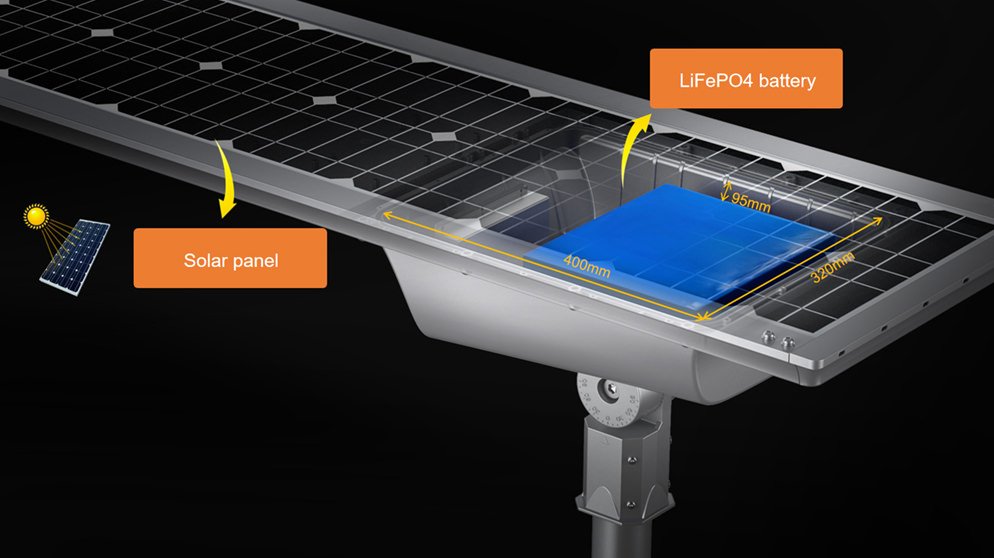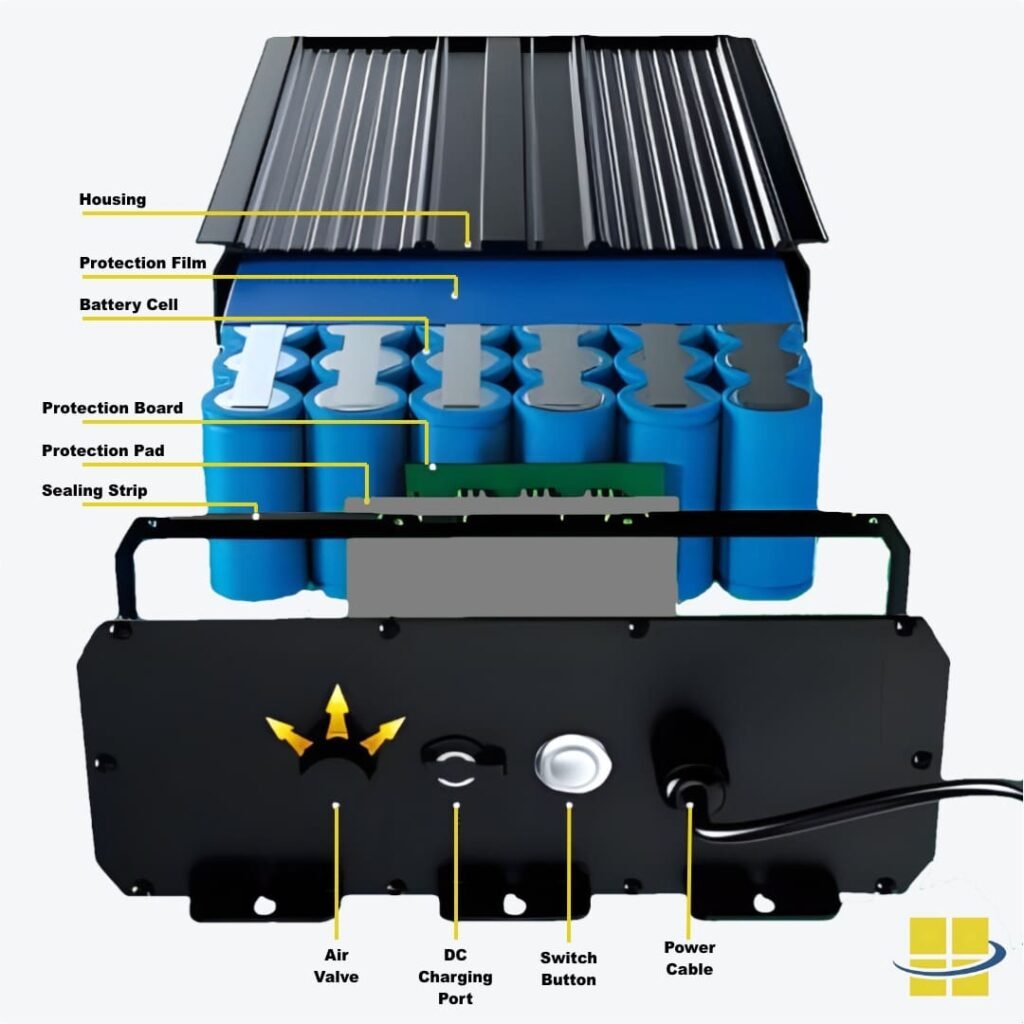LiFePO₄ batteries (Lithium Iron Phosphate) have redefined how long and how safely solar lights can operate — combining stability, longevity, and sustainability in one chemistry. **
Unlike conventional lithium-ion or lead-acid batteries, they resist overheating, deliver over 2,000–5,000 charge cycles, and perform reliably across Africa’s demanding climates.
I. Introduction: The Future of Outdoor Lighting Power
For years, solar lighting was limited not by the panels — but by the batteries behind them.
Today, the innovation engine of outdoor lighting is no longer wattage or design; it’s battery chemistry.
As Dr. Lee Pan, a materials scientist specializing in advanced energy storage, puts it:
“The next frontier in outdoor lighting isn’t brighter LEDs — it’s smarter batteries.”
From grid-tied systems to hybrid solar setups, we’re witnessing a rapid shift toward self-sustaining, battery-integrated lighting.
Emerging technologies like lithium-sulfur, solid-state, and the widely proven LiFePO₄ chemistry are leading this revolution — offering longer lifespans, safer operation, and cleaner energy footprints.
II. Market Evolution: Why Battery Technology Matters
2.1 Global Market Overview
Between 2025 and 2030, the global outdoor lighting battery market is projected to grow at a CAGR of 11–13%, surpassing USD 18 billion in value.
This growth is powered by:
- Urban infrastructure expansion
- Sustainability-driven procurement
- Off-grid and rural electrification projects
In Africa, Southeast Asia, and the Middle East, public agencies increasingly favor battery-solar hybrids for street and security lighting due to grid instability and fuel costs.
2.2 Key Industry Shifts
Battery evolution has followed a clear timeline:
- Lead-acid → Lithium-ion → Post-lithium chemistries
- Smart lighting → Solar-integrated hybrid systems
- Reactive control → Predictive, sensor-based management
In this landscape, LiFePO₄ batteries have become the “trusted middle ground” — offering proven chemistry and scalable reliability.
III. Next-Generation Battery Chemistries Shaping Outdoor Lighting
3.1 Lithium–Sulfur Batteries: Lightweight Powerhouses
Lithium–sulfur (Li–S) batteries promise 350–500 Wh/kg of energy density — nearly twice that of standard lithium-ion.
Their structure replaces heavy metal oxides with sulfur, cutting costs and improving recyclability.
These are ideal for remote monitoring poles, drone-based lighting, and smart light towers where weight matters.
3.2 Solid-State Batteries: The Safety Revolution
By using solid electrolytes instead of liquids, solid-state batteries eliminate the risk of leaks or fires.
They perform well even at 60–80°C, making them perfect for desert solar farms or oilfield infrastructure.
The trade-off? Cost and limited mass production — though both are improving quickly.
3.3 LiFePO₄ Batteries: The Proven Workhorse
This is where performance meets practicality.
LiFePO₄ batteries deliver:
- Cycle life: 2,000–5,000 cycles
- Thermal stability: Operate safely up to 70°C
- Voltage consistency: 3.2V per cell with steady discharge
- Chemistry safety: No thermal runaway or fire risk
For street, garden, and security lights, this chemistry has become the backbone of reliable systems.
Compared to NMC/NCA lithium-ion cells, LiFePO₄ offers lower energy density but much longer life — and far better heat resistance.
In one Kampala lighting pilot, LiFePO₄-powered poles ran uninterrupted for three rainy seasons, while NMC-based models required two battery replacements.
3.4 Multivalent Batteries (Magnesium, Calcium, Zinc)
These emerging “multi-electron” batteries promise lower cost and higher safety.
Each ion carries more charge, potentially doubling capacity at minimal material cost.
Research is ongoing — scalability and raw material access remain challenges.
3.5 Comparative Performance Table
| Battery Type | Energy Density (Wh/kg) | Cycle Life | Temp Range | Safety | Best Use Case |
|---|---|---|---|---|---|
| Lead-Acid | 30–50 | 500–800 | -10–45°C | Moderate | Basic solar lamps |
| Li-ion (NMC/NCA) | 180–250 | 800–1500 | -10–55°C | Medium | Compact, high-output lights |
| LiFePO₄ | 90–140 | 2,000–5,000 | -20–70°C | Excellent | Street, garden, and smart lights |
| Solid-State | 250–400 | 1,000–3,000 | -20–80°C | Outstanding | High-temp environments |
| Li–S | 350–500 | <1,000 | -10–60°C | High | Lightweight mobile units |
IV. Smart Integration and Intelligent Power Management
4.1 IoT-Enabled Lighting Systems
Modern solar lights now think for themselves.
AI algorithms and IoT sensors adjust brightness, detect motion, and schedule dimming automatically — reducing power draw and extending battery life by 30–40%.
Predictive maintenance alerts help technicians replace parts before failures occur.
4.2 Hybrid Solar–Battery Configurations
Today’s solar systems combine solar, grid, and USB backup inputs.
Smart controllers switch sources depending on sunlight, load, and time of year.
LiFePO₄’s steady voltage curve makes it perfect for this kind of adaptive charging.
4.3 Fast-Charging and BMS Evolution
Next-gen materials prevent lithium plating, improving high-rate charging.
Advanced Battery Management Systems (BMS) monitor every cell’s temperature and state of charge, balancing them in real time.
This preserves over 90% capacity even after years of daily cycling.
4.4 Energy Optimization Techniques
Features like motion-based dimming and load balancing help extend battery life further.
Efficient LEDs, when paired with LiFePO₄ batteries, maximize each watt-hour captured by solar panels — critical in regions with variable daylight.
V. Solar Synergy: Battery + Panel Optimization
5.1 High-Efficiency Solar Panel Materials
New solar modules — bifacial, perovskite, and thin-film — now achieve conversion rates of 22–28%.
When paired with stable LiFePO₄ storage, even small panels can sustain long illumination hours.
5.2 Matching Solar Panels and Batteries
A well-matched system is crucial.
For example:
- Garden light: 20W panel + 6.4V 6Ah LiFePO₄ battery
- Street lamp: 100W panel + 12.8V 40Ah LiFePO₄ pack
- Industrial tower: 250W panel + 25.6V 100Ah modular system
5.3 Energy Storage Management
Smart charge controllers predict usage patterns and weather.
They balance daily generation with nighttime demand, ensuring consistent brightness even through cloudy stretches.
VI. Design Innovation and Durability
6.1 Modular Battery Packs
Swappable LiFePO₄ modules simplify maintenance and recycling.
Large-scale infrastructure projects now use standardized plug-in battery blocks — reducing downtime and cost.
6.2 Weather Resistance and Thermal Design
High IP-rated housings (IP66–68) prevent moisture ingress.
Aluminum heat sinks dissipate temperature spikes, especially in equatorial regions.
“In solar lighting, thermal design is 50% of reliability,” notes Dr. Pan. “Even the best battery fails without proper cooling.”
6.3 Adaptive Lighting Features
Auto-dimming, adjustable color temperature, and remote control systems are now standard.
Integration with security cameras and smart city grids transforms simple lights into intelligent assets.
VII. Sustainability and Environmental Responsibility
7.1 Green Battery Materials
LiFePO₄ chemistry uses iron and phosphate, not cobalt or nickel — drastically reducing environmental and ethical sourcing issues.
7.2 Rechargeable vs Disposable
Rechargeable LiFePO₄ systems can reduce CO₂ emissions by 60–70% compared to disposable or diesel-powered lighting over 5 years.
Governments across Africa and Asia now include rechargeable-only tenders for public lighting.
7.3 Battery Recycling and Circular Economy
Global recycling initiatives (EU Battery Regulation 2025, China’s GB/T standards) encourage recovery of lithium, iron, and phosphorus for reuse.
Recycled LiFePO₄ materials are now reentering new lighting products at scale — closing the sustainability loop.
VIII. Business and Economic Outlook
8.1 Reliability and Certification
Key certifications: UN38.3, CE, UL 2054, RoHS, ISO 9001.
Compliance ensures safe transport and boosts trust in international tenders.
8.2 Cost Efficiency and ROI Analysis
Compared to diesel generators or wired systems, solar + LiFePO₄ lighting cuts OPEX by 50–70% over five years.
Minimal maintenance, no fuel costs, and long cycle life guarantee quick payback.
8.3 Market Forecast (2025–2030)
With government-led green initiatives, the LiFePO₄ lighting market in Africa alone is projected to exceed USD 3.2 billion by 2030.
Top growth sectors include municipal street lighting, industrial zones, and off-grid communities.
IX. Expert Insights: What Comes After Lithium?
Beyond LiFePO₄ lies a new wave — solid-state, sodium-ion, and graphene hybrid systems.
AI-driven BMS designs will soon make self-healing batteries a reality, where systems autonomously balance cells and predict degradation.
Dr. Pan envisions:
“By 2030, outdoor lighting will be self-sustaining, intelligent, and completely off-grid.”
X. Frequently Asked Questions
Q1: Which battery lasts longest for solar lighting?
A: LiFePO₄ — up to 5,000 cycles, with excellent thermal stability.
Q2: Why are solid-state batteries safer?
A: They use solid electrolytes that eliminate liquid leakage and fire risk.
Q3: How do smart systems extend solar battery lifespan?
A: Through predictive dimming, temperature control, and adaptive charging.
Q4: Can lithium batteries be recycled safely?
A: Yes, especially LiFePO₄, as it contains no toxic cobalt or nickel.
Q5: What’s the ideal battery for large-scale street lighting?
A: 12.8V or 25.6V LiFePO₄ systems with modular packs and advanced BMS.
XI. Conclusion: Powering the Future Responsibly
Outdoor lighting is entering its smartest and most sustainable era.
As solar panels reach higher efficiency and LiFePO₄ batteries provide unmatched reliability, lighting systems are becoming fully autonomous, low-maintenance, and eco-responsible.
The future isn’t just bright — it’s battery-powered, intelligent, and sustainable.





